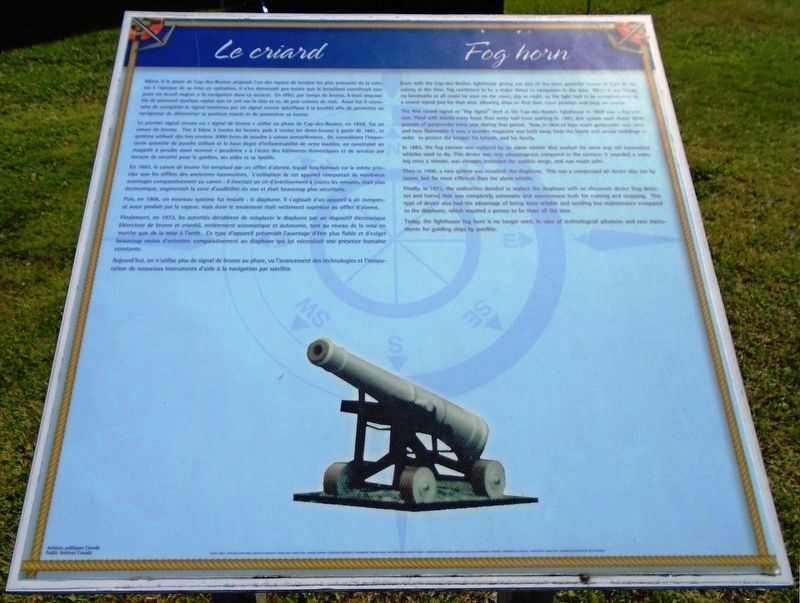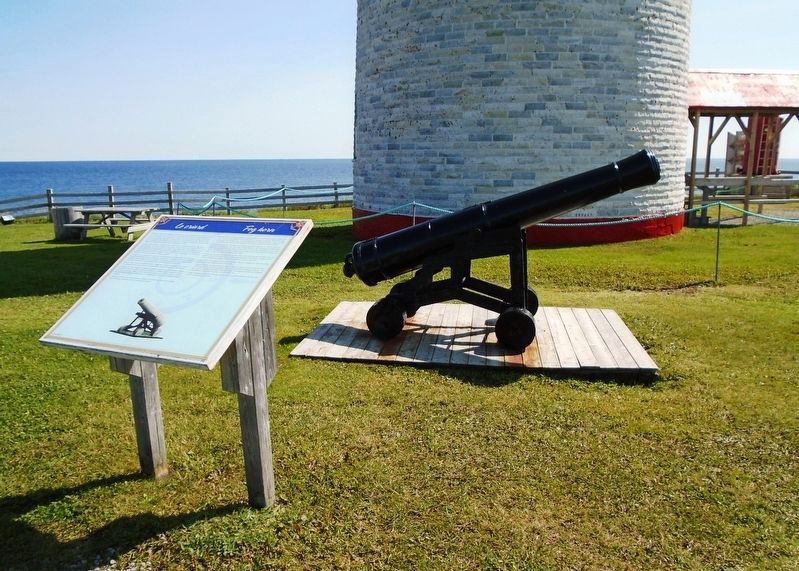Le criard / Fog horn
Même si le phare de Cap-des-Rosiers projetait l'un des rayons de lumière les plus puissants de la colonie à l'époque de sa mise en opération, il n'en demeurait pas moins que le brouillard constituait toujours un écueil majeur à la navigation dans ce secteur. En effet, par temps de brume, il était impossible de percevoir quelque repère que ce soit sur la côte et ce, de jour comme de nuit. Aussi fut-il nécessaire de compléter le signal lumineux par un signal sonore spécifique à la localité afin de permettre au navigateur de déterminer sa position exacte et de poursuivre sa course.
Le premier signal sonore ou « signal de brume » utilisé au phare de Cap-des-Rosiers, en 1858, fut un canon de brume. Tiré à blanc à toutes les heures, puis à toutes les demi-heures à partir de 1881, ce système utilisait dès lors environ 3000 livres de poudre à canon annuellement. Or, considérant l'importante quantité de poudre utilisée et le haut degré d'inflammabilité de cette matière, on construisit un magasin à poudre aussi nommé « poudrière » à l'écart des bâtiments domestiques et de services par mesure de sécurité pour le gardien, ses aides et
sa famille.En 1882, le canon de brume fut remplacé par un sifflet d'alarme, lequel fonctionnait sur le même principe que les sifflets des anciennes locomotives. L'utilisation de cet appariel comportait de nombreux avantages comparativement au canon : il émettait un cri d'avertissement à toutes les minutes, était plus économique, augmentait la zone d'audibilité du son et était beaucoup plus sécuritaire.
Puis, en 1906, un nouveau système fut installé : le diaphone. Il s'agissait d'un appareil à air compressé aussi produit par la vapeur, mais dont le rendement était nettement supérieur au sifflet d'alarme.
Finalement, en 1972, les autorités décidèrent de remplacer le diaphone par un dispositif électronique (détecteur de brume et criards), entièrement automatique et autonome, tant au niveau de la mise en marche que de la mise à l'arrêt. Ce type d'appareil présentait l'avantage d'être plus fiable et d'exiger beaucoup moins d'entretein comparativement au diaphone qui lui nécessitait une présence humaine constante.
Aujourd'hui, on n'utilise plus de signal de brume au phare, vu l'avancement des technologies et l'instauration de nouveaux instruments d'aide à la navigation par satellite.
Even with the Cap-des-Rosiers lighthouse giving out one of the most powerful beams of light in the colony at the time, fog continued to be a major
The first sound signal or "fog signal" used at the Cap-des-Rosiers lighthouse in 1858 was a fog cannon. Fired with blanks every hour, then every half-hour starting in 1881, this system used about 3000 pounds of gunpowder every year during that period. Now, in view of how much gunpowder was used, and how flammable it was, a powder magazine was built away from the house and service buildings in order to protect the keeper, his helpers, and his family.
In 1882, the fog cannon was replaced by an alarm whistle that worked the same way old locomotive whistles used to do. This device was very advantageous compared to the cannon: it sounded a warning once a minute, was cheaper, extended the audible range, and was much safer.
Then in 1906, a new system was installed: the diaphone. This was a compressed air device also run by steam, but far more efficient than the alarm whistle.
Finally, in 1972, the authorities decided to replace the diaphone with an electronic device (fog detector and horns) that was completely automatic and autonomous both for starting and stopping. This type of device also had the advantage of being more
Today, the lighthouse fog horn is no longer used, in view of technological advances and new instruments for guiding ships by satellite.
Erected by Cap-des-Rosiers Lighthouse Maritime Historical Site.
Topics and series. This historical marker is listed in these topic lists: Communications • Waterways & Vessels. In addition, it is included in the Lighthouses series list. A significant historical year for this entry is 1858.
Location. 48° 51.378′ N, 64° 12.072′ W. Marker is in Gaspé, Québec, in La Côte-de-Gaspé. Marker can be reached from Boulevard de Cap des Rosiers. Marker is on the grounds Cap-des-Rosiers Lighthouse Maritime Historical Site. Touch for map. Marker is at or near this postal address: 1323 Boulevard de Cap des Rosiers, Gaspé QC G4X 6G7, Canada. Touch for directions.
Other nearby markers. At least 7 other markers are within walking distance of this marker. Le phare de Cap des Rosiers Lighthouse (a few steps from this marker); Passer le cap / Keeping on course (within shouting distance of this marker); La tour - La "light" / The tower - The light (within shouting distance of this marker); Gaspé, une ville au coeur de la découverte (within shouting distance of this marker); Cloche du "Carrick's" voilier Irlandais / Bell of the "Carrick's" Irish Sailboat (approx. half a kilometer away); Carricks of Whitehaven Shipwreck Memorial (approx. half a kilometer away); Hommages aux Anciens / Honoring Our Pioneers (approx. 0.8 kilometers away).
Related marker. Click here for another marker that is related to this marker.
Also see . . .
1. Cap des Rosiers Lighthouse. Lighthouse Friends website entry (Submitted on January 28, 2019, by William Fischer, Jr. of Scranton, Pennsylvania.)
2. Lieu historique national du Canada du Phare-du-Cap-des-Rosiers. Parcs Canada website entry (Submitted on January 28, 2019, by William Fischer, Jr. of Scranton, Pennsylvania.)
Additional keywords. Le criard / Fog horn
Credits. This page was last revised on November 24, 2023. It was originally submitted on January 27, 2019, by William Fischer, Jr. of Scranton, Pennsylvania. This page has been viewed 171 times since then and 19 times this year. Photos: 1, 2. submitted on January 28, 2019, by William Fischer, Jr. of Scranton, Pennsylvania.

